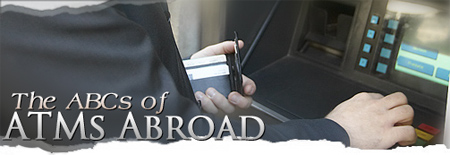
Tips
for Using ATMs While Traveling Internationally
It
use to be the standard. Along with passports
and airline tickets, travelers would
always remember to bring their travelers'
checks. However, today fewer merchants
are accepting traveler's checks, and
with the relatively high fees for buying
and cashing them, many travelers have
moved on to credit, debit and ATM cards.
As the major source of funding for travelers,
these cards can be risky to use if the
right safety precautions are not taken.
Here are some tips for using ATMs for
transactions while traveling internationally.
-
Visa
and Mastercard charge a one percent
fee for all foreign transactions,
and most banks will tack on an additional
two percent charge for converting
ATM transactions to U.S. dollars.
Check with your credit, debit and
ATM card providers to determine which
of your cards are the most travel-friendly.
You can also sign up for a new card
with a provider that waives or reduces
the international fees.
-
Make
sure you have ample available credit
and/or funds deposited. Also, check
the expiration dates on your cards.
-
Many
foreign ATMs accept four-digit PINs
only, and often times they don't even
display letters on their keyboards.
If you use a word for your PIN, memorize
its numeric equivalent before traveling.
-
Unusual
foreign transactions may be flagged
as fraudulent, so let your credit,
debit and ATM card providers know
of your travel plans prior to your
departure. This will ensure they do
not freeze your account once you begin
making international transactions.
Also, take more than one card with
you just incase one of your accounts
is accidently frozen.
-
Make
a list of convenient ATM locations
in your destination cities before
leaving. Both Visa
and Mastercard
have on-line worldwide ATM locators
that cover more than 210 countries.
Make sure that your card displays
a Visa, Mastercard, Cirrus or Plus
logo for worldwide acceptance.
-
Prepaid
debit cards are a safe, albeit more
expensive, alternative to a traditional
debit or ATM card. Simply purchase
the necessary value ahead of time
and use the card in ATMs while traveling.
Since the card is in no way connected
to your checking account, there is
no danger if your card is lost or
stolen. However, these prepaid cards
usually have additional fees attached.
-
Make
all of your purchases in local currency
and beware of merchants offering to
convert your purchases into U.S. dollars.
Merchants can inflate the exchange
rates by as much as five percent.
-
Cash-to-Cash
machines are common, especially in
Europe. They look like ATMs, though
you feed in currency rather than your
card. Despite being convenient, the
machines often charge inflated exchange
rates. The same may be true for the
currency exchange booths at many international
airports.
Exchange
rates and commission fees can be very
expensive when converting foreign currency
back to U.S funds. Try to limit all
cash withdrawals to just what you need.
Use your remaining currency for that
last lunch or souvenir, or tuck it away
until your next trip.
Source
— Magellans
|